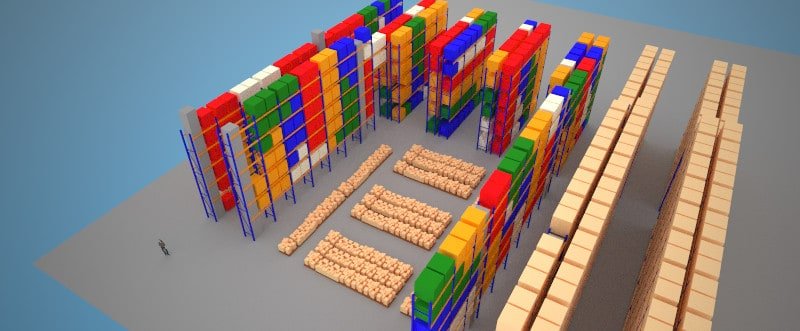In the rapidly evolving landscape of logistics and supply chain management, harnessing the power of technology is a strategic imperative. When it comes to the intricate art and science of warehouse design, one tool emerges as a transformative force: advanced warehouse design software. This sophisticated solution has become indispensable, offering unparalleled advantages in optimizing warehouse layouts, resource utilization, and overall operational efficiency.
Rethinking Warehouse Layouts with Intuitive Software
Warehouse design is not merely about arranging shelves and aisles; it’s about creating a dynamic and adaptable space that meets the demands of a modern supply chain. Warehouse design software goes beyond conventional methods, providing a holistic platform to strategically organize and optimize warehouse spaces. The software’s intuitive features empower design teams to visualize, analyze, and iterate on different layouts with real-time feedback.
In the realm of layout planning, these tools shine by offering features such as real-time space utilization tracking, equipment placement optimization, and workflow analysis. Traditional design methods often rely on static layouts, making it challenging to adapt to changing inventory needs and operational dynamics. Warehouse design software, on the other hand, allows for dynamic simulations, enabling teams to foresee potential challenges and optimize layouts for maximum efficiency.
The integration of artificial intelligence (AI) algorithms takes warehouse design to new heights. Predictive analytics can anticipate future storage requirements, helping design teams create layouts that not only accommodate current inventory but also scale seamlessly with the growth of the business. This forward-looking approach ensures that the warehouse design remains relevant and efficient in the long term.
Streamlining the Design Process for Maximum Efficiency
Efficiency in warehouse design is a multifaceted goal. It involves not only creating a layout that maximizes storage but also one that optimizes workflows, minimizes travel time, and ensures easy accessibility. Warehouse design software addresses these challenges by providing features that streamline the design process.
Imagine a scenario where design teams can simulate different workflows, test the placement of equipment, and analyze the impact of design decisions on overall operational efficiency—all within the software interface. This level of detail ensures that every aspect of the warehouse design is thoroughly examined before the physical construction begins.
Furthermore, these software solutions often come with a library of pre-built design elements, including racks, shelves, conveyors, and more. This library not only accelerates the design process but also ensures that design teams adhere to industry best practices. By incorporating elements that are tried and tested for efficiency, warehouse design software contributes to creating layouts that are not only visually appealing but also operationally sound.

Maximizing Space Utilization for Optimal Results
Space optimization is a perpetual challenge in warehouse management. Traditional methods often fall short in utilizing every square foot effectively. Warehouse design software revolutionizes the game by providing advanced 3D modeling capabilities. This isn’t just about creating a digital representation of the warehouse; it’s about creating a virtual twin that accurately mirrors the physical space.
Design teams can leverage the 3D model to visualize the placement of every shelf, the flow of goods, and the interaction of personnel with the space. This level of detail is crucial for identifying potential bottlenecks, optimizing the placement of high-demand items, and ensuring that every inch of the warehouse is contributing to operational efficiency.
The software allows for the creation of different scenarios, testing the impact of various design decisions on space utilization. For example, what if the receiving area is moved closer to the shipping area? How would that affect the overall flow of goods? Warehouse design software enables teams to answer these questions through simulations, ensuring that the final design is not just a static layout but a dynamic and adaptable space.
Real-time Collaboration for Seamless Design Workflow
Collaboration is the heartbeat of effective design, especially in a field as intricate as warehouse management. Warehouse design software recognizes the importance of real-time collaboration and integrates features that facilitate seamless communication among design teams.
Teams can work concurrently on different aspects of the design, share feedback instantly, and make necessary adjustments on the fly. This collaborative approach not only accelerates the design process but also ensures that the final layout meets the specific needs and preferences of the organization.
The software often comes with cloud-based collaboration tools, allowing team members to access the design from anywhere, fostering a flexible and agile design workflow. Whether team members are in the same office or scattered across different locations, warehouse design software ensures that everyone is on the same page, literally and figuratively.
Ensuring Precision with Automated Design Processes
Manual design processes are not only time-consuming but are also prone to errors, leading to costly mistakes in warehouse construction. Warehouse design software mitigates this risk by automating routine tasks, reducing the margin for human error.
Automated design calculations, equipment placement suggestions, and workflow optimizations contribute to a more accurate and reliable warehouse design. For instance, the software can automatically calculate the optimal placement of racks based on the dimensions of the space and the types of items being stored. This not only speeds up the design process but also ensures that the design is optimized for operational efficiency.
The integration of automation also extends to documentation. Warehouse design software can generate detailed reports, including floor plans, equipment lists, and workflow diagrams, with a click of a button. This not only saves time but also ensures that all stakeholders have access to comprehensive and accurate documentation for the construction phase.
Future-proofing Warehouse Designs
As technology continues to advance, the capabilities of warehouse design software are set to evolve. Machine learning algorithms and artificial intelligence integration are on the horizon, promising even greater efficiency and predictive design analysis.
One exciting prospect is the ability of the software to learn from past designs and operational data. Imagine a warehouse design software that can analyze the performance of previous layouts, identify areas of improvement, and automatically incorporate these lessons into new designs. This iterative learning process ensures that each design is not just a static plan but a continuously evolving blueprint for efficiency.
The concept of the digital twin, where the virtual model of the warehouse is in sync with its real-world counterpart, is another frontier that warehouse design software is exploring. This real-time synchronization opens up possibilities for even more accurate simulations, allowing design teams to test the impact of changes on the actual, ongoing operations of the warehouse.
By investing in such software now, businesses are not just designing a warehouse; they are future-proofing their warehouse designs, staying ahead of the curve in an ever-changing industry.
In Conclusion: A Strategic Imperative for Modern Warehousing
In the dynamic landscape of warehouse management, staying competitive requires embracing the latest technologies. Warehouse design software is not just a tool; it’s a strategic imperative. Its ability to enhance efficiency, streamline operations, and provide real-time insights positions it as the cornerstone of modern warehouse design.
In a world where adaptability is key, where the ebb and flow of supply chain dynamics demand precision and flexibility, warehouse design software emerges as the linchpin of success. As organizations navigate the challenges of a rapidly evolving industry, those armed with the power of advanced warehouse design software are not just designing warehouses; they are crafting the future of efficient and agile logistics.
